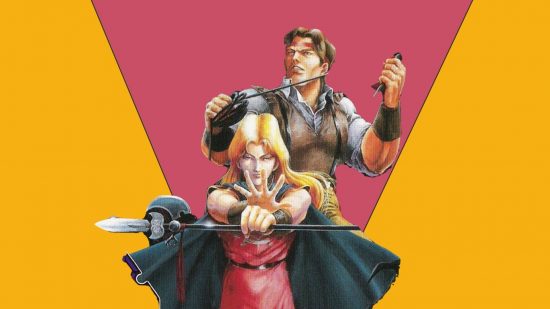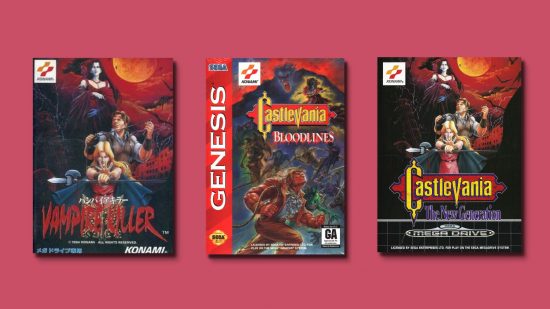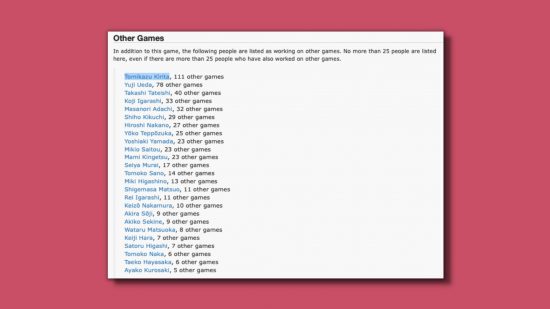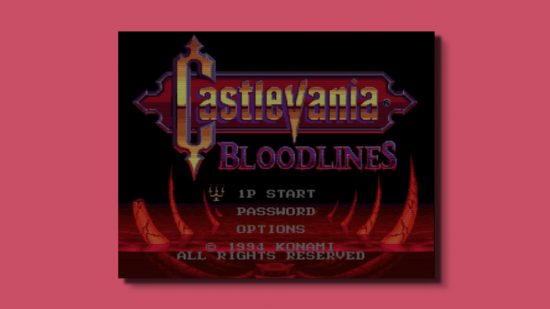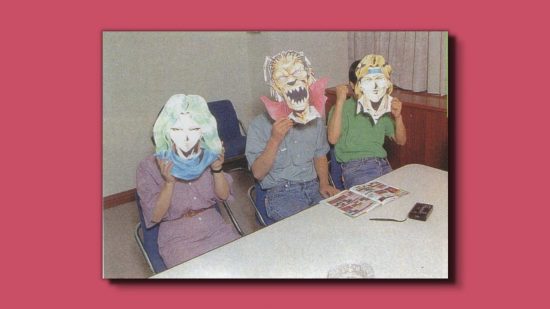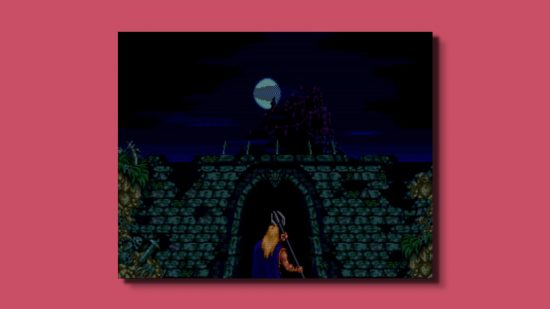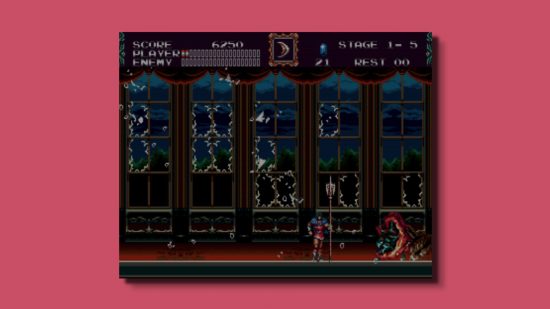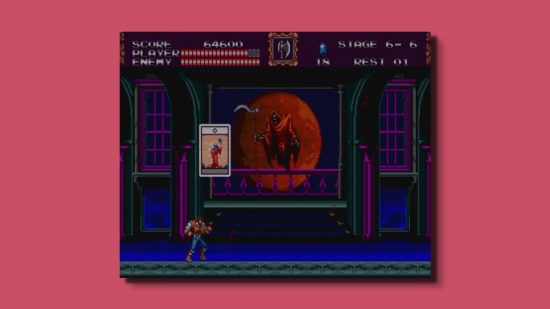Castlevania: Bloodlines, also known as Vampire Killer in Japan and Castlevania: The New Generation in Europe, is a videogame developed by Konami for the Sega Genesis and released in March of 1994. Produced by Tomikazu Kirita, written by Toshiki Yamamura, and with music by Michiru Yamane, it’s a bit of a forgotten gem in the venerated franchise.
The reason it first piqued my interest was the release year: 1994. If you line up a list of notable releases from 1994 it’s not unlikely that it isn’t included. There’s stiff competition – Mother 2, Super Metroid, NBA Jam, Sonic & Knuckles, Donkey Kong Country, Ridge Racer, Final Fantasy VI, and Doom II, just to name a few.
It was a year where we had Tekken, King’s Field, and a bloodless Mortal Kombat II on the SNES. It is a year overflowing with excellent stuff. (Every time I try and finish this list I find a new one; Tokimeki Memorial! System Shock! Contra Hard Corps!). Castlevania: Bloodlines is sidelined next to all that videogame excellence.
But even if we look at the series itself, Bloodlines lives in a strange space in the collective consciousness of what “the good Castlevania games” are. Symphony of the Night? Yeah, that’s pretty alright. Rondo of Blood? Maybe the best in the series. Bloodlines? Also maybe the best in the series.
It’s the last of the classic Castlevania games, refining the early formula in a year where many series refined their formulas. While Symphony takes Rondo and Metroid and goes wild, Bloodlines takes the history of Castlevania to that point and tightens it. It’s fuelled by its excellent level design, hot graphics, and perfect soundtrack.
Or, at least, that’s what I’m here to argue. But not by way of gameplay dissection, no, by way of pedigree. There are a handful of interesting people we can look at behind Bloodlines’ development, as well as what it means to the history of Castlevania as a whole. And, by the end, you may just agree with me.
Let’s start then, with a screenshot. Producer Tomikazu Kirita also worked on Tokimeki Memorial, a 1994 Japanese dating sim. For research, I looked over the Moby Games credits page for the game. By the time you reach the bottom, it gives you a ranked list of people based on how many other games they’ve worked on.
As you can see, Tomikazu Kirita has worked on a lot of videogames. 111 other games, according to Moby. He was a producer on Sparkster, Contra Hard Corps, and Hideo Kojima’s Snatcher. He’d go on to be a supervisor on Demon’s Souls, Boku no Natsuyasumi 3, and Uncharted. Neat. Let’s keep going down the list.
Voice actor Yuji Ueda has 76 others, mostly legendary fighting games. Takashi Tateishi has 40 others, including Tenchu, Vandal Hearts, and Suikoden. Pretty cool. And next up is Koji Igarashi. Now, where have I heard that name before… looks like he’s worked on, um, thirteen Castlevania games. Oh, and those two Bloodstained games as well.
So, before Koji Igarashi got the chance to make Symphony of the Night, he was working on Tokimeki Memorial. While this was going on, Tomikazu Kirita was starting a prestigious career with the legendary dating sim, a Hideo Kojima visual novel, and a Castlevania. A spin-off, to be exact. And the first Castlevania to come to a Sega console.
The game the team eventually brought to the Mega Drive is a unique one in the Castelvania bloodline, sitting between two classics in Rondo of Blood and Symphony of the Night, yet looking back at the series rather than imagining its future.
And I think it interesting to thread the lineage in that way. While Symphony of the Night is the Castlevania game, the one that everyone reveres, Bloodlines, at the time, was probably more Castlevania than any other Castlevania game. The type of thing fans now call Classicvania.
In one of the few interviews available regarding Bloodlines’ development, writer Toshiki Yamamura talked about his influences; “As you can probably gather from the fact that Vampire Killer is set in a different era from the previous games, the scenario is unique to the Mega Drive, and is my personal conception of the Dracula series.
“In my mind, there is a trilogy or tri-partite structure to the Dracula saga, and this game takes the place of the second act. Of course, I’m a big fan of the previous Castlevania games too, so I wanted continuity in terms of style and image. I’d like players to see Vampire Killer as my personal interpretation of the canon. I was pretty influenced by Hideyuki Kikuchi’s work.”
Hideyuki Kikuchi is the writer of the Vampire Hunter D series of novels. If you haven’t heard of them, fair enough, but they’re a pretty big deal. It has sold over 17 million copies worldwide, more than The Hitchhiker’s Guide to the Galaxy and His Dark Materials (of course, the fact that the series has 39 instalments helps quite a bit, but still).
One interesting thing Yamamura also highlights is the differences between regional releases of the game; “if you find Vampire Killer too easy for you, be sure to check out the overseas version, Castlevania Bloodlines. It’s like the ‘tabasco’ version of Vampire Killer, in terms of difficulty.” The New Generation, the European release, is also a less gruesome version than the NA and Japanese versions, interestingly.
So, we have a producer just starting a career that would make for an eye-watering resumé, a writer influenced by legendary Japanese fiction offering his own interpretation of the series, and a videogame that sits in a unique position within a revered series. Oh, and we also have Michiru Yamane’s breakthrough soundtrack to talk about.
Michiru Yamane is arguably just as vital to Castlevania as Koji Igarashi. While she’d worked on other Konami titles like Ganbare Goemon 2 and Sparkster before, Castlevania: Bloodlines was a far bigger deal.
In an interview with the composer in 2010, she shared some details regarding the pressure she faced; “Now and then I met unknown employees, for example in the elevator, asking me if I was the composer for the music to the new Castlevania game. I said ‘yes’ and then got comments like ‘make sure you do a good job’. I didn’t feel less pressure from getting such comments! (laughs)”.
The Castlevania series was already a big deal, of course, and Michiru Yamane being given the sonic reins was obviously a hefty responsibility. But, as you probably know already if you have any interest in Castlevania, she created one of the best Mega Drive soundtracks out there.

Taking influence from a wide range, whether it’s reincorporating classic tracks or utilising her classical music knowledge, the Castlevania: Bloodlines soundtrack balances baroque grandeur and unsettling minor melodies alongside driving, energetic segments.
Most interestingly, Michiru Yamane studiously looked at previous Castlevania songs. In fact, she was asked to; “I was told to listen to the music from the previous games and the instruction I got was to follow the theme and not to break from this when composing the music.”
In another interview, she fleshes out how diligently she analysed the series’ musical history; “Some great musical works already existed from the previous Castlevania games and I gained inspiration from tracks such as “Vampire Killer”, “Beginning”, and “Bloody Tears” especially, which have become the standard tunes for the series now […] I analysed the compositions to find out the secret of their charm and composed so I didn’t create something inferior to previous works.”

The reason I find this so interesting is because, while tunes like Vampire Killer are at the heart of the series, Michiru Yamane has become synonymous with the Castlevania sound at this point. She’d go on to compose for Symphony of the Night, a similarly excellent soundtrack, and also did composition on Igarashi’s Konami-less venture Bloodstained. If you have any reverence for the series, Bloodlines is where some of its iconic facets were solidified.
This applies gameplay-wise too, not just to the people behind its creation. Bloodlines features two playable characters – the classic whip-wielder John and the spearman Eric. The latter plays in a radically different way from the other, changing the structure of the levels and the difficulty.
“The whip is of course inseparable from the Castlevania series,” Yamamura said, “but we wanted to do something unique for the Mega Drive, so we added a character who wields a spear. If you master Eric’s spear move, the fights should be easy.” This also led to different paths through the game for the two heroes, though not on the same level as Rondo or Symphony.
Then there’s the gorgeous sprite work, with clever shading and different sections lending this clever 2D depth to characters and bosses alike. The gore factor also shot through the roof, with Konami flexing its skill for hot Mega Drive graphics. And, what’s more, it’s preserved beautifully in the excellent Castlevania Collection, which includes easy save states, scan lines, and a bunch of other quality-of-life improvements.
So, we have Castlevania: Bloodlines, a 1994 videogame that has some important names attached yet feels kinda forgotten. It’s a game that pushes the series forward in smart and interesting ways, while being wrapped in a gorgeous package, both in the way it looks and the way it sounds. And it needs to be on more people’s minds.
In that pre-release interview, Yamamura ups the mysticism of this forgotten gem’s development; “our misfortunes have been so numerous, we’ve honestly wondered if we ourselves are not cursed… It all started with this evil tapestry we hung in the development room for atmosphere. Everyone said to take it down, but I refused, and instead affixed some ofuda to ward off the evil. I’ll have to put some more up after this.”
Maybe that curse led to people being disappointed by what they felt was the lack of innovation Bloodlines showed. But, in reality, 1994 was a year of refinement for many great games. It’s the end of an era, just before the PS1 and the Sega Saturn, with familiarity breeding a bit of boredom. But Castlevania: Bloodlines is a finely tuned Castlevania, and it easily competes with the best in the series. And if you haven’t given it a try, you really should.
Join us next month for more history. What’re we looking at? Well, I’m not sure yet. Talking about 1994 has made me want to talk about Contra: Hard Corps, though I suck at that game so… I’ve been playing a bit of Phantasy Star recently, which is super interesting, maybe we’ll do a deep dive there. Either way, one thing’s for certain: I’ll be back if you like it or not.
